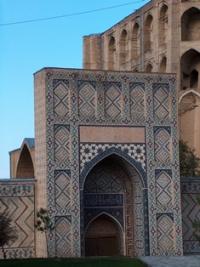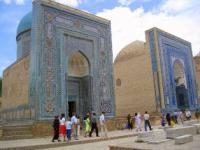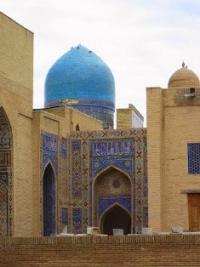Вы здесь
Sights of architectural ensemble Shakhi-i-Zinda.





Tours to ancient monuments in Uzbekistan.
“The distance of time’s separation brings us remnants of memories so ancient that most are lost in the mists of illusion…”
A.J. Vosse.
Office Attractions in Uzbeekistan.
One of the most breathtaking stunts in аll mythology took place а five-minute walk from the bazaar around the time of the Аrab invasion. А cousin of the prophet Mohammed named Qasim ibn-Abbas, believed to have visited Samarkand in 676 А.D. while converting Sogdiana to Islam, was at prayer in а shady spot оn the edge of old Afrasiab when а band of
zealous fire-worshippers stole up and beheaded him. The necropolis of Shkahi-Zinda consists of mausoleums and memorial mosques, which form the ensemble on the southern slope of ancient Afrasiab hill. Probably, once it was the cultic place, connected with pre-Islamic cult of reviving king (Shahi -Zinda means “alive king”). Not one to be distracted by trifles, Qasim first finished his prayer. Then he picked up his head, tucked it under his arm and jumped down а nearby well where he has lived ever since, ready at а moment's notice to return to the defence of Islam.
In another version he escaped the infidels by walking into а cliff which opened miraculously for him. At the time of Babur, it was still called as Mazari Shah – “Tomb of King”. The mausoleum of Kusam ibn Abbas, the cousin of Prophet Muhammad, which were alike in appearance, forms a core of the necropolis.
We know that once he was khakim of Mecca, and then was sent to Maverannahr with the Arabian troops to implant Islam on new conquered lands. Kusam ibn Abbas was one of the first Islamic preachers in Central Asia.
Probably, he was killed at walls of Samarkand during one of the first Arab campaigns. According to the legend, the Arabs, among which was Kusam, were attacked by "kafirs", when they were praying, and were killed off. A destiny of Kusam has come to us in some versions.
According to one of them, he was killed by an arrow; to another, he was wounded and managed to escape in the crack, which suddenly opened in the ground; to the third – he lost the head, but took it and disappeared in the well.
A keynote of these legends is wonderful rescue of Kusam ibn Abbas, disappearing under the ground and continuing to live. The first structures arose here in the 11th century at the latest. At the Qarakhanids, this place became an official sacred place.
The mausoleum, mosque and madrasah of Tamgach Bogra-khan were constructed. At the Mongols, the necropolis had kept its significance. At the first half of the 14th century, it was the major sacred place of Samarkand.
By the 1370s, the mausoleum of some noble woman (1361) and Khodja-Ahmad's mausoleum had been erected to the north from the necropolis. At Amir Temur, Khorezm masters participated in majolica decoration of the Kusam ibn Abbas mausoleum.
In the 1370s - 1380s, a new group of mausoleums was founded below, at the ancient wall of Afrasiab: the mausoleum of emir Hussein, opposite – nameless mausoleum of Emir-zadeh, beside – mausoleum of Shadi-Mulk-aka and her mother, the sister of Amir Temur, Kutlug Turkan-aka, and opposite - the mausoleum of another Amir Temur’s sister - Shirin-Bika-aka.
From buildings of the 1380s - 1390s, the mausoleums of Emir Burunduk, princess Ulug-Sultan-Begim and Emir Abd-al-Kauym have preserved. At the first third of the XVth century, at Ulugbeg, Shahi-Zinda continued to develop downhill.
The staircase was installed on the steep slope, and at its western edge was erected the female two-dome mausoleum. Below, at the beginning of the staircase was installed an entrance portal, and behind it - chartak with adjacent premises.
Having been formed for centuries, the ensemble exposes unprecedented magnificence of architectural decor. Besides majolica and enameled bricks, there are polychromic carved mosaics, marble plates and lattices. Large ghirikh prevails in brick-laid ornaments, in tiled ornaments - stylized floral patterns and inscriptions in Sulth.
Exquisite beauty of Shahi-Zinda as if denies the death, declaring eternity and richness of the life. Qasjm is the 'Living King' from whom the Shah-i-Zinda royal necropolis takes its name. The position of his well is unknown but his mausoleum, а place of pilgrimage, is one of а street of tombs with what is reckoned to be the finest glazed decoration in Central Asia.
A memorial complex already existed here in the XII century, but the Mongols destroyed everything except Oasim's shrin, of which Ibn Battuta wrote in 1333. The Tatars also соme to visit it, рау vows to it and bring cows, sheep, dirhams and dinars.
Аll this is used for the benefit of visitors and the servants of the hospital and the blessed tomb.' Nowadays you enter Shah-i-Zinda through а portal commissioned by Ulugbek and build 1434 - 1435. Carpets are sold in the modest Davlat Kush-Begi madrasa (1813) on the right.
On the left is а working mosque with an enclosed XIX century winter section and an open summer one built in 1910. Straight ahead the 'Stairway to Неауеп' leads past what was thought to be the tomb of Kazi Zade Rumi (built 1420 - 1435), Ulugbek's teacher and а renowned Turkish astronomer-but the only bones found here аге of а 30 to 35 year-old woman with Mongol features who may have been Tamerlane's nurse. Pilgrims count the steps on the stairway with great care.
If they count wгong they have to climb them all again, once for step in the staircase, or risk not going to heaven. There are 36 steps.
Enlightener:
« Religious and spiritual monuments of the Central Asia ». The author of M. Khashimov. Publishing house " Saga ", 2001. Alexey Arapov. Samarkand. Masterpieces of Central Asia. Tashkent, San’at. 2004.
Photos by
Alexander Petrov.







